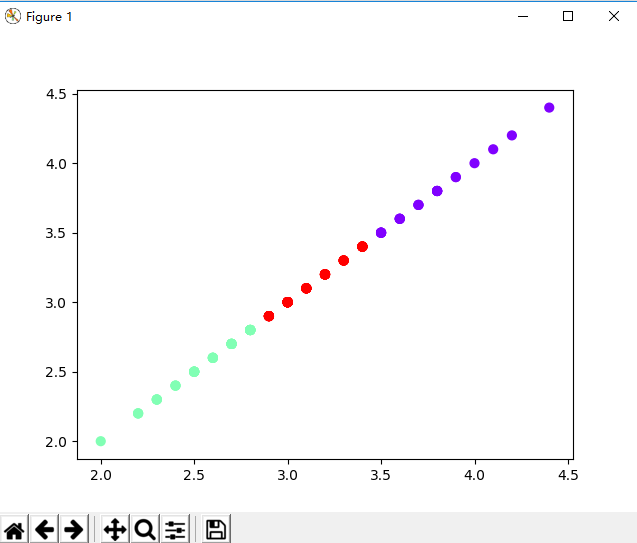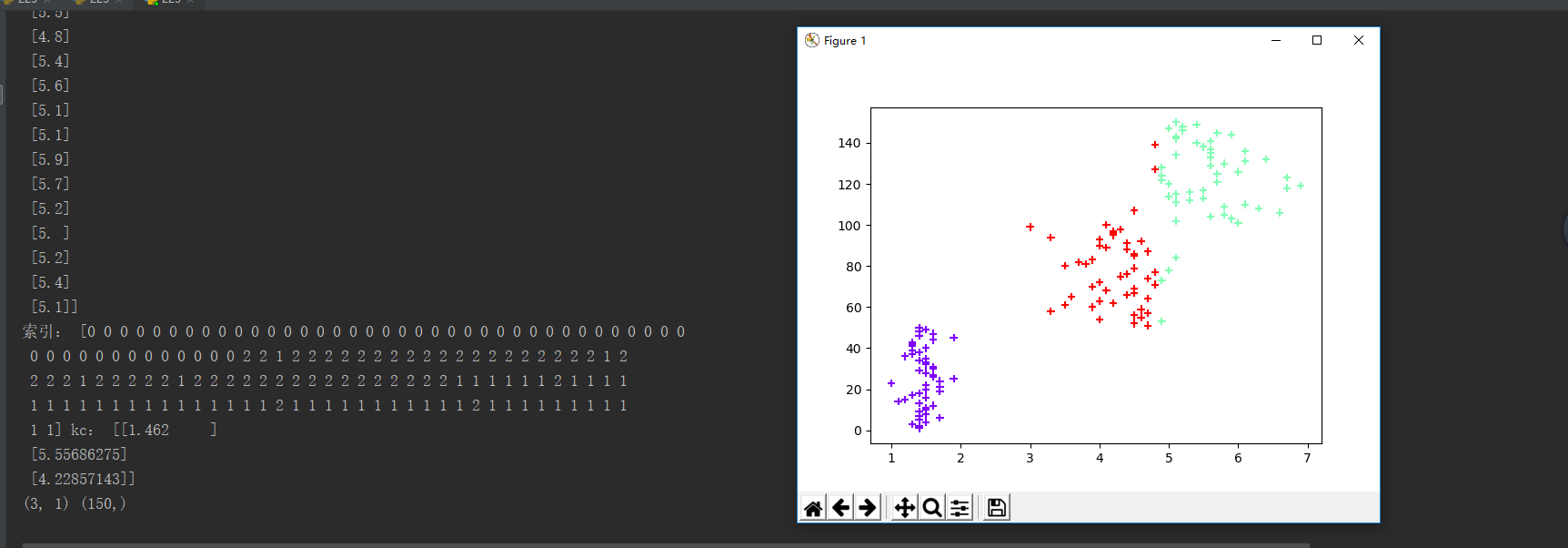作业八
import numpy as np ##从1到100随机生成一个20行1列的数组 x = np.random.randint(1,100,[20,1]) print(x.shape) print(x) ##返回来一个给定形状和类型的用0填充的数组; y = np.zeros(20) print(y) ##给定聚类中心的值 k = 3 #numpy.where(condition[, x, y]) # 1、这里x,y是可选参数,condition是条件,这三个输入参数都是array_like的形式;而且三者的维度相同 # 2、当conditon的某个位置的为true时,输出x的对应位置的元素,否则选择y对应位置的元素; # 3、如果只有参数condition,则函数返回为true的元素的坐标位置信息; ##定义初始中心函数 返回k值 def initcenter(x,k): return x[:k] ##定义一个nearset函数 def nearest(x,i): d =abs(kc - i)##聚类中心减去数值 abs()返回距离的绝对值 w = np.where(d == np.min(d))#进行距离最小的分类 返回数组的形式 距离最近的赋给d 把距离最近的数组成一个数组赋值给w return w[0][0] #返回数组w def kcmean(x,y,kc,k): l = list(kc) flag = False for c in range(x.shape[0]): m = np.where(y == c) if m[0].shape != (0,): n = np.mean(x[m]) if l[c] != n: l[c] = n flag = True return (np.array(l),flag) def xclassify(x,y,kc):##定义xclassify函数 for i in range(x.shape[0]):#循环遍历数组x y[i]=nearest(kc,x[i])##把离kc最近的x的值赋给y分成k类作为y的元素 return y kc = initcenter(x,k) flag = True print(x,y,kc,flag) while flag: y = xclassify(x, y, kc) kc,flag = kcmean(x,y,kc,k) print(y,kc,type(kc)) print(x,y)

#2)鸢尾花花瓣长度数据做聚类并用散点图显示。 import numpy as np import sklearn from sklearn.datasets import load_iris iris=load_iris() x=iris.data[:,1] y=np.zeros(150) #1、选取K个对象作为初始中心, def initcent(x,k): return x[0:k].reshape(k) #2、返回数组中的值,与聚类中心最小距离所在类别的索引号 def nearest(kc,i): d = (abs(kc - i)) w = np.where(d == np.min(d)) return w[0][0] #3、更新聚类中心:将每个类别中所有对象对应的均值作为该类别的聚类中心 def kcmean(x, y, kc, k): #计算各聚类新均值 l = list(kc) flag = False for c in range(k): m = np.where(y == c) if m[0].shape != (0,): n = np.mean(x[m]) if l[c] != n: l[c] = n flag = True #聚类中心发生变化 return (np.array(l),flag) #2、 def xclassify(x, y, kc): for i in range(x.shape[0]): #对数组的每个值分类 y[i] = nearest(kc, x[i]) return y k = 3 kc = initcent(x, k) #4、判断聚类中心和目标函数的值是否发生改变,若不变,则输出结果,若改变,则返回2 flag = True print(x, y, kc, flag) while flag: y = xclassify(x, y, kc) kc, flag = kcmean(x, y, kc, k) print(y, kc) import matplotlib.pyplot as plt plt.scatter(x, x, c=y, s=40, cmap='rainbow'); plt.show()


#3)用sklearn.cluster.KMeans,鸢尾花花瓣长度数据做聚类并用散点图显示. import numpy as np from sklearn.cluster import KMeans from sklearn.datasets import load_iris iris=load_iris() data=iris.data print(data) #全部数据 #取出所有花瓣的长度 pe_len=data[:, 2:3] print("花瓣长度:",pe_len) k=KMeans(n_clusters=3) #表示类簇数为3,聚成3类数据 est=k.fit(pe_len) kc = est.cluster_centers_ #类簇中心(cluster centers) y_kmeans = est.predict(pe_len) #预测每个样本的聚类索引 print("索引:",y_kmeans,"kc:",kc) print(kc.shape,y_kmeans.shape) import matplotlib.pyplot as plt plt.scatter(pe_len,np.linspace(1,150,150),c=y_kmeans,marker="+",cmap='rainbow') plt.show()

#(4)鸢尾花完整数据做聚类并用散点图显示. import numpy as np
import matplotlib.pyplot as plt from sklearn.cluster import KMeans from sklearn.datasets import load_iris iris=load_iris() data=iris.data print(data) est=KMeans(n_clusters=3) est.fit(data) kc=est.cluster_centers_ y_kmeans=est.predict(data) print(y_kmeans,kc) print(kc.shape,y_kmeans.shape,data.shape) plt.scatter(data[:, 0], data[:, 1], c=y_kmeans, s=50,marker="+",cmap='rainbow') plt.show()

